#meteorites
Photo

Meteor strikes around the world.
by u/Ricky-Nutmeg
1K notes
·
View notes
Link
A metallic-looking rock that smashed through the roof of a residential home in New Jersey’s Hopewell Township earlier this week is indeed a meteorite — a rare one about 4.6 billion years old, scientists confirmed on Thursday (May 11).
"It was obvious right away from looking at it that it was a meteorite in a class called stony chondrite," Nathan Magee, chair of the physics department at The College of New Jersey (TCNJ), whose office was contacted by the Hopewell Township police soon after the rock was found on Monday (May 8), told Space.com.
Chondrites are primitive rocks that make up 85% of meteorites found on Earth. Most chondrites found to date have been discovered in Antarctica; only rarely does one crash in populated areas.
The New Jersey rock, which is about 6 inches long by 4 inches wide (15 by 10 centimeters), is a notable exception. It slammed into the Hopewell Township house, dented the floorboard, punched two holes in the ceiling and was still warm when it was discovered by Suzy Kop in her father's bedroom around noon on Monday.
Continue Reading
473 notes
·
View notes
Text


Winter Solstice - Part 3
Part 1 and 2 -> here
And so they decided to let Ji Ho be claimed by Caleb to make it easier for Vlad to claim him back... and because everyone thinks Ji Ho hit the lottery with Caleb ^^'
And then finally, finally Vlad and Jeb made their way back from the Otherworld! But where are their shirts?

They ran over to the temple. Hopefully in time!
Ouf! Luckily Genji was quick-witted enough to steal some time. He started an argument with Lady Demon about that Ji Ho is his bonded and it's not legal to steal him away from him and give him to Caleb...


Vlad: "What is going on here?" (Vlad and Jeb really had no idea what is going on here. They went over the fence to the Otherworld and hadn't heard of Ji Ho since they travelled to the Tomarang with the ship from Selvadorada.)

Saiwa: "Gods, Jeb!" *hungry kiss*
Vlad went to the altar to stop this madness: "Ji Ho is mine!"

Genji: "Hey, Caleb. How about we two share a coffin?"
Genji is very clever. He started the argument with Lady Demon not only for Ji Ho and Vlad. He wanted to hit on Caleb ;)

Now that Ji Ho's rightful bonded is back, they decided to make their bond official in vampire terms so no one ever will question it again and try to claim Ji Ho while Vlad is in the Otherworld.


Ji Ho: "Let's go over to the sanctuary and fix your eyes..."

And that's what they did.

They undressed and kissed.

Ji Ho: "Claim me."

And that's what Vlad did.

Outtakes
When I added Vlad and Jeb to the household during Ji Ho and Caleb's ceremony, Vlad spawned there and looked so sad.

Poor Lady Demon. The lucrative deal with Ji Ho is called off.
But she will get a pretty penny for setting up Caleb with Genji too ;)

And finally Vlad asked Ji Ho to be his boyfriend.
Vlad: "From now on, no one will ever touch you again."
Ji Ho: "But I want you to touch me."
... *sigh*

From the Beginning ~ Underwater Love ~ Latest
🛺 'Home crappy Home' from the beginning ▶️ here
📚 Previous Chapters:
🌴 'The Expedition' from the beginning ▶️ here
🎤 'Putting the Boys Back together' from the beginning ▶️ here
🥀 'Disbandment of the Group' from the beginning ▶️ here
#home crappy home#sims 4 story#simlit#sims 4#ts4 story#ts4#simblr#underwater love#winter solstice 2023#sims 4 for rent#woo ji ho#genji okada#rubyn montana#meteorites#goats#mount komorebi#town centre#jack callahan#giga byte#saiwa#dtui ngyen#lady demon#caleb vatore#the guitar
63 notes
·
View notes
Text

This year's postcard design features... well, me :D
It has become a tradition of mine to send Christmas/New years cards to all my Patr0ns in December. I wanted to try something different this year, I hope you all like it 🌠✨🌠
138 notes
·
View notes
Note
I want to see meteorites
well lucky for you, i just took a whole class on planetary geology, so here's a couple of fun meteorites.
but first, a definition. meteorites are fragments of the primordial solar nebula that were not accumulated into the present planets or come from planets in our system.
widmanstatten structures are very cool and present in many meteorites and look like the photo below. they are brought out by acid etching meteorites after cutting and polishing them. they are thought to be formed in the centers of planetary and smaller bodies, and probably what the earth's core looks like.
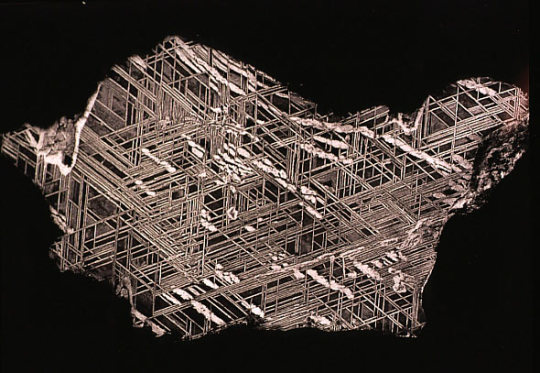
stony-iron meteorites are popular favorites for slabs because they often are a mix of, as you might guess, iron and olivines. they look like this:

among the famous meteorites is allan hills 84001, a carbonaceous meteorite found in antarctica and from mars made famous for the potential biotic (made by living creatures) structures. this one has been the subject of heated debate, but personally i'm not convinced that it's biotic.
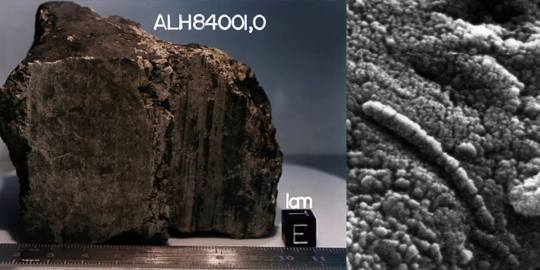
and another famous meteorite, angra dos reis. this is one of 6 meteorites classified as an angrite, a meteorite that (might be) from mercury. angrites are cool as hell and there's a lot out there about them and why they may or may not be from mercury, too much for me to discuss in this post, but i definitely recommend looking into them because they're really interesting.
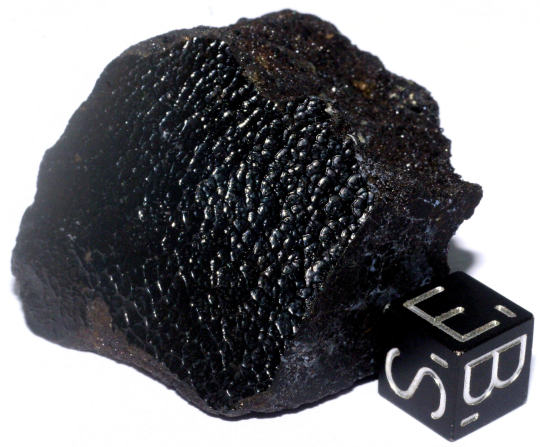
meteorites are super cool! if you want to learn more, looking into the research around the two meteorites is a good intro to how meteorite research works, the challenges that comes with studying extraterrestrial objects, and the rigorous scientific debate that occurs within the planetary geology community. enjoy!
72 notes
·
View notes
Text
Renowned Harvard physicist Avi Loeb has pulled metals out of the Pacific Ocean that landed on Earth from a meteorite from another solar system! This is the first interstellar material ever recovered on Earth.
41 notes
·
View notes
Text
Currently working on meteorite based patterns — this one's on barred olivine chondrules, a constituent of stony or chondritic meteorites. Chondrites are the oldest unaltered rocks in our solar system, and contain some of the earliest materials to have condensed from the early solar nebula (chondrules, CAIs). Some even contain presolar grains which come from interstellar sources.
Chondrules are flash heated silicate grains with igneous textures. Of these, barred olivine chondrules are arguably the prettiest, exhibiting a form of skeletal growth (which in turn indicates a large degree of supercooling).

Some reference examples (how pretty!):
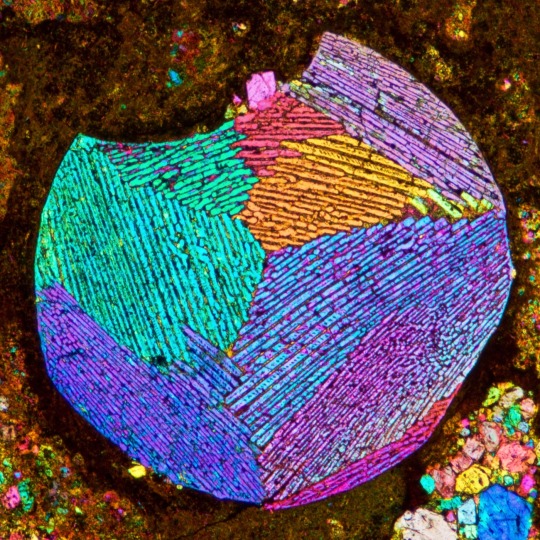


170 notes
·
View notes
Text
Meteorite is a rock from space. It starts as a chunk of a larger object, like an asteroid or comet, that breaks apart. When a piece falls towards Earth, the friction with our atmosphere heats it up, making it glow and often burning most of it away. Read more here:
13 notes
·
View notes
Text
Did you know (cuz I didn't)
...that meteorites AREN'T hot when they land? The movies lied to all of us!
It turns out that they only spend a few seconds flaming through the atmosphere, which can be enough to melt the outside layer (called a "fusion crust"), but not to make a dent in the deep freeze of the center. Outer space is cold. Some fresh meteorites have even been reported with frost on them.
So if you do find a hot rock, that's what the scientists call a "meteorwrong."
#science!#meteors#meteorites#meteorwrongs#fun with language#love the clever terminology#scientists have fun#debunking#in spaaace
52 notes
·
View notes
Text
guys, the universe is so fucking cool.
did you know that if you started forming a cloud of elements (like, smashing their protons and electrons together) about 20-17 million years ago, at the same time that the hominid apes started appearing on earth at the beginning of the neogene, those elements would already be a fully differentiated planet by today. with a core, mantle, and crust. A solid planet. That you could stand on.
do you have any idea how fast that is, on a cosmological/geological time scale? for reference, it took about 175x longer for life on earth to evolve from unicellular life to complex multicellular life. you can build a planet faster than the entire history of complex life on earth. that’s SO FAST. That’s faster than it took to build the Appalachian mountains. by 230 MILLION YEARS.
and that’s not just smashing bits of ready-made rock together to make the planet, that’s forming them FROM ATOMIC DUST.
And the reason we know this is by studying iodine gas in crystals inside of chondritic meteorites. The stuff that you clean wounds with, or eat in seaweed chips. We used the decay of Iodine-129 into Xenon to figure out the amount of time it takes to build a planet out of a cloud of dust. And it’s less time than it took for humans to evolve from gorillas.
Impossible, enormous things are happening around us all the time. the universe is so fucking cool.
#geology#xenogeology#space#astronomy#melusina minerals#rockblr#i’m simplifying a bit because i don’t want to overcomplicate the message and confuse people#i mean obviously humans evolved simultaneously with gorillas from a common ancestor#but also the iodine and xenon in meteors isn’t just gas. and it’s very specific types of meteors#meteors#meteorites#the point is though. the earth formed SO FAST#in comparison to how long the earth has been around#that’s like the blink of an eye
96 notes
·
View notes
Photo

Map that illustrates 4, 516 found meteorites that have fallen to Earth’s surface since 301 AD
178 notes
·
View notes
Text
Earth and the rest of our solar system's inner, rocky planets are the products of a myriad of tiny planetesimals — glorified pebbles of primordial cosmic dust — assembling themselves together more than 4 billion years ago. Now, a new analysis suggests that those planetesimals already contained water.
Researchers tested samples from meteorites that they say are just as ancient as those planetesimals. In doing so, they found the fingerprints of chemical reactions known to occur in the presence of water.
Continue Reading.
70 notes
·
View notes
Text

There was no way to find out more about Professor Callahan and his research online. It was too long ago and the prediction (of an impact of a meteorite pair in the far future made by an unknown professor without any evidence) too insignificant.
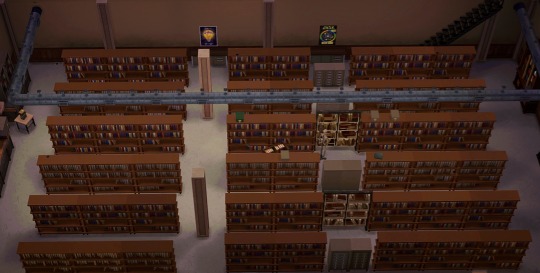
So Rubyn went over to Foxbury. To the archives. Where all the pre-internet astronomical data are kept - on paper.
The Librarian wasn't of much help...

So Rubyn spent her night in the archives. Searching through card indexes...

Consultating catalogues...

And finally a trace lead her to the personnel file of a Professor J.Callahan. Who had been a lecturer for astronomy at the Britechester University a hundred years ago. Long before Foxbury Institute had been built.

The reason why any information about him was so hard to find is, that he only taught for a few days. Published his article about the ...

... Tepesz-Woo meteorite pair (???)
What? A Professor -> J. Callahan (and only him) predicted the impact of Ji Ho and Vlad's meteorites and named them after them - a hundred years ago?
(Ji Ho's last name is 'Woo' and Vlad's 'Tepesz'. And Jack's -> Callahan...)
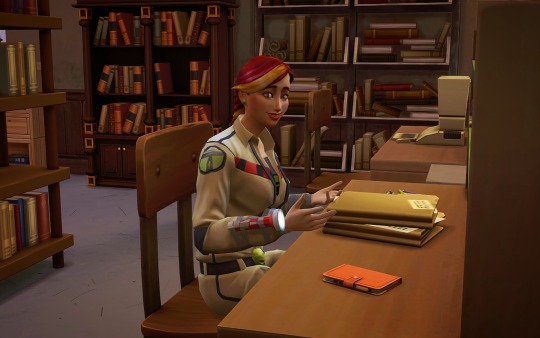
Unfortunately Professor Callahan lost his professorship due to his, then unprooved, weird theories. The last entry in his file is, that the University of Britechester wishes him good luck for his further research in Selvadorada...
TMI: This episode is inspired of a real life experience where I was lucky to spend hours and hours in the Library of our University and in the endless Archives. It was stunning.

From the Beginning ~ Underwater Love ~ Latest
'Putting the Boys Back together' from the beginning -> here
Previous Chapter:
'Disbandment of the Group' from the beginning -> here
#putting the boys back together#simlit#sims 4 story#sims 4#simblr#ts4#rubyn montana#foxbury institute#britechester#underwater love#sims 4 vanilla#Professor Callahan#meteorites
64 notes
·
View notes
Photo


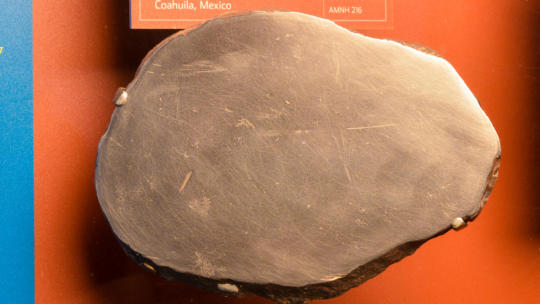


Alloys: Meteoric iron
A native metal (i.e., metals found in their pure metallic states), meteoric iron is a combination of iron and nickel found in meteorites. It could be argued that this material is a combination of minerals, however both definitions fit, as the minerals involved are themselves combinations of iron and nickel, so the alloy classification stands as well. The two main minerals - or alloys - in meteoric iron are kamacite and taenite.
Kamacite is found on Earth only in meteorites and is around 90-95% iron. Taenite has a wider variety of compositions, and can be from 20-65% nickel. When kamacite and taenite are found together, they can form a plessite texture. Other elements present in these natural alloys include cobalt, sulfur, phosphorus, and carbon, in limited amounts.
Many meteoric iron samples have Widmanstätten microstructures, long lamellae of interwoven kamacite and taenite, as pictured in images 1 and 5 above. Many other metals and alloy systems form Widmanstätten structures as well, so the definition is not limited to kamacite and taenite. However, while these structures are not limited to meteorites, iron doesn’t form Widmanstätten structures on Earth, at least not to the same scale, given that it only forms in meteorites after millions of years of cooling, so any iron with this structure must be meteoric iron.
The microstructure seen in image 4 is plessite, as mentioned above, while the meteorite in image 3 is a single crystal, with no microstructure to speak of. Historically, meteoric iron has been used across the globe for a variety of applications, as it was a ready source of iron on the surface that typically didn’t require mining.
Sources/Further reading: ( 1 - image 1 ) ( 2 - image 2 ) ( 3 - image 3 ) ( 4 - image 4 ) ( 5 - image 5 ) ( 6 ) ( 7 )
#Materials Science#Science#Alloys#Iron#Meteorites#Space#Minerals#Microstructures#MyMSEPost#MaterialsPosts
46 notes
·
View notes
Text
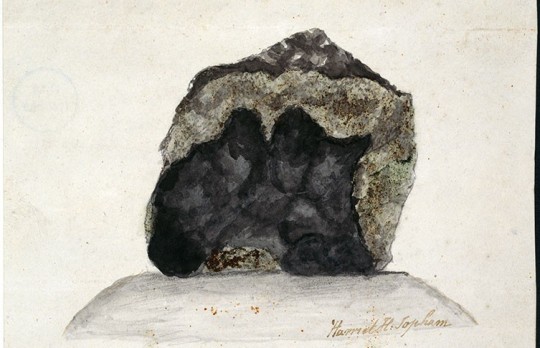
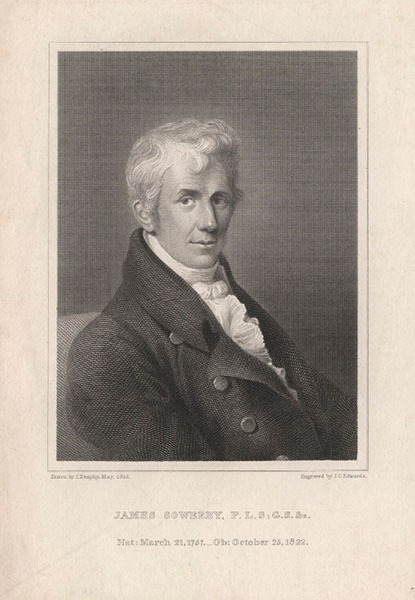

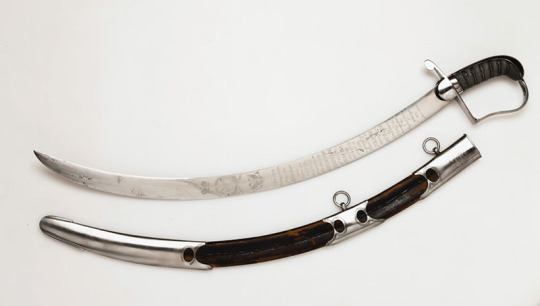
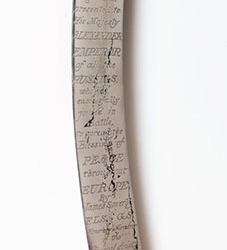

James Sowerby – Scientist of the Day
James Sowerby, an English artist, collector, and engraver, died Oct. 25, 1822, at age 65.
read more...
#James Sowerby#meteorites#engraving#botany#histsci#histSTM#19th century#history of science#Ashworth#Scientist of the Day
17 notes
·
View notes
Text

Arrowhead housed at Bern History Museum found to be made from meteoritic iron - Phys org
An international team of geologists and historians has found that an arrowhead housed at the Bern History Museum was made using meteoritic iron. In their paper published in Journal of Archaeological Science, the group describes the attributes of the arrowhead and where they believe the material it was made of came from.
Prior research has shown that meteoritic iron was used by early people in many parts of the world, from Eurasia to the Middle East and Africa. Notably, researchers have found few examples of use of meteoric iron by early people in Europe. Suspecting that many such artifacts have been found but not identified as such, the team on this new effort conducted a search of archaeological collections at various sites in Switzerland.
Testing of an arrowhead found at the Bern History Museum showed it was made partly of aluminum-26 isotopes, which are not found naturally on Earth. They also found an iron and nickel alloy that has only ever been detected in meteorites.
In checking its history, the team found that the arrowhead had been discovered at what had once been a Bronze Age site called Mörigen...
The team also found remnants of an adhesive on the arrowhead, which they guessed to be tar pitch, suggesting that the arrowhead had been attached to a shaft of some sort.
The researchers noted that the site where the arrowhead was found is less than eight kilometers from the point where the Twannberg meteorite crashed into the ground, making it the likely source of the iron used to make the arrowhead. But upon closer inspection, the team found that the concentrations of germanium and nickel did not match. That led them to look for another source.
A search of a geological database showed that only three meteorites with the right combination of metals had been found in Europe: one in the Czech Republic, another in Spain, and the third in Estonia. The research team suggests that the one in Estonia was the most likely source for the arrowhead they studied—an example of the extensive trade network that was active during the Bronze Age in Central Europe.
9 notes
·
View notes